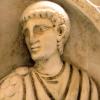Leaderboard
Popular Content
Showing content with the highest reputation on 2015-08-29 in all areas
-
Add to the list! I'll keep adding to the list. I'll alphabetize once we get some input. ARMS ARMOUR -- Chieres/Manica: Segmented armour for the arms of a soldier (usually for a cavalryman) . Notably used by the Romans during the Dacian Wars and by Eastern "cataphract" style cavalry. -- Chamfron: Armour for the face of a horse. -- Peytral: Skirt armour for the chest of a horse. -- Is there a separate name for the horse chest armour that is one solid piece rather than a skirt? -- Parameridia: A piece of armour for a cavalryman's legs, usually scale mail or lamellar mail over layers of leather. They often look like small "wings" on the side of a horse. -- Crupper: Armour for the hind-quarters of a horse. -- Gorget: A single piece of armour protecting the upper chest/neck area of a soldier. -- What is the scale neck collar for the Persians called? -- Tube & Yoke Corselet: Synonymous with the apocryphal "linothorax." -- Thorax: Body armour. Cuirass. -- Hemithorax: Half-cuirass or breastplate. Presumably referring to metal armour only covering the chest or front. -- Greaves: Shin guards. Can "snap" over the shin and be held in place by the calves, or fastened with straps. -- Lorica Segmentata: A modern term for the segmented Roman armour of the Trajan era. -- Lorica Hamata/Hauberk: Chain mail body armour. -- Lorica Squamata: Roman/Latin term for scale mail body armour. -- Pteruges: Groin straps; overlapping strips of linen or leather that protect the lower part of the body, sometimes a far down as the knees.1 point
-
Roman Arms and Armor (Some of these are corrections): Weapons: Pugio: The long, wide Roman dagger, likely modeled after the Xiphos, used by Late Republic and Principate Era Roman soldiers (100 BC - 200 AD) Gladius Hispaniensis: A Short Sword between 22 and 28 inches long used until approximately 250 BC through 50 BC by Republican infantry. Gladius Pompeiensis: A modern term for the classic "Pompeii-Type Gladius" that featured from roughly 25 AD through 250 AD by Roman Infantry. Spatha: A Roman longsword used by Cavalry that first appeared in about the time of Marius, and by 250 AD was also used by Roman Infantry. There are a number of Spatha types, including Lauriacum-Hromovka, Gold Hilt Spathae, etc. Hasta: The 7-foot Roman spear. It was later called the Contus and was lengthened to 8-10 foot by the 4th century AD. Pilum: The Roman heavy javelin identified by use of a tang, a four-sided pyrimidal point, and a long 60-90cm Iron shaft. It was in use as early as about 300 BC, and was phased out by about 250 AD. It was standard for Roman Heavy infantry at that time. Spiculum: A Late Roman version of the Pilum, which had a shorter 30-60cm Iron shaft, a barbed head, and was socketed rather than tanged. Lancaea/Verrutum: Two names for the Roman Light Javelin, which had a leaf-bladed or pyramidal head. The term Verrutum only dates to the Late Roman Era (250-630 AD) but the Lancaea was used from the Early Republic to the Late Empire (300 BC - 630 AD) Scutum: The Roman shield, usually rectangular-ish in shape. In the Late Era it just meant shield in general. Clipeus: A term referring to the Ovoid shields used by the Auxiliaries in the Late Republic and Principate. It was also used by Cavalry, and sometimes was Hexagonal. Parma: A Smaller Round shield, used by the various officers like the Vexillarius, Aquilifer, Tubicen, Cornicen, etc. Armor: Lorica Hamata - The actual Roman term for maile armor, which was adopted by the Romans from the Greeks or the Gauls in the 3rd century BC. It remained in use until the Fall of Constantinople in 1453, but underwent some design changes. Lorica Squamata - The Roman term for Scale and Lamellar armor. It was in use before Hamata and remained in use until 1453 as well. It also referred to Roman Scale gorgets and Roman Scale coifs. Lorica Segmentata - The modern term for the Roman segmented armor, which was in use from about 14 AD to 280 AD Lorica Plumata - A term for rigid scales attached to a maile backing, was highly decorative and added little aditional defense, but had a huge psychological effect because they were shiny and looked like feathers. Lorica Musculata - The Roman term for their Bronze, and later Iron, Muscle Cuirasses. Pectoralis - The Small Breastplate used by Republican Roman soldiers, IIRC it also referred to the Three-Disc armor as well. Subarmalis - A very light, thin leather or linen undergarment for armor, equipped with Pteruges which were strips that hung down from the arms or over the thighs. It was actually very uncommon amongst infantry, although used often by officers. Thorocomachus - The Late Roman Subarmalis, which was about an inch thick and made of linen with a goatskin covering. This was actually designed to absorb blunt force blows, unlike the Subarmalis. Balteus: The Roman Belt. The decorative strips hanging down that displayed a soldier's wealth were each called a Cingulum and are often mistaken for a groin guard. In the Republican era, Cingulum may have also referred to the Second belt worn by Roman soldiers. Cassis/Galea - Terms for the Roman helmet Oracae (Also Ocrea) - Greaves Manica - Roman segmented arm armor in use from about 50 AD through about 600 AD. Tunica - The Roman Tunic. The Tunica Manicata was the decorative Late Roman version. Sagum - Roman Rectangular cloak. The Abolla was very similar and popular in the Republic and Late Empire. Paenula - Roman hooded cloak, rectangular or ovoid in shape. Cucullus - A Roman hood. Fascia Ventralis - Cloth waist sash worn under a belt or for lack thereof Udones - Socks Caligae - The Classic Roman sandals in use from about 50BC through 150 AD Calcei/Carbatinae - Roman boots, the difference was their construction. Calcei were 1-piece construction while Carbatinae were 2 piece construction. Later on, low-sided boots were called Campagi and these date from the 4th-6th centuries AD. Pileus Pannonicus - Roman Pillbox cap popular from the 2nd through 5th centuries AD Pileus - Roman descendant of the Greek Pilos cap. Phrygian caps may have also been called this. Greek Arms and Armor: Armor: Mitra - A small groin plate used on the Bell Cuirass, not the Muscle Cuirass. These fell out of use beginning in about the 5th century BC. Spolas (pl. Spolates) - A Greek Tube and Yoke Cuirass, made of thick, heavy leather and udually painted. This is what is depicted and mistaken for the so called "Linothroax." Linothorax - A Greek thick, quilted linen armor. It was not made of glued linen as popular belief would have it, and was likely adopted from Egyptian quilted linen armor.1 point
-
Scutum (Roman) The Famous Roman Shield. Pilum Roman Javelin. Hoplon/Aspis (Greek ὅπλον) The Greek Round Shield. Hence the Greek soldiers name "Hoplite* derives from the hoplon shield. Lorica Squamata Roman scalemail armour. Galea (Roman helmet) Pugio (Roman Dagger)1 point
-
Greek ARMS -Dory Spear 6-10 ft in length, primary weapon of the Hoplite. Unique features of the Dory are that the shaft narrows towards the head and it has a pointed counterbalance(sarouter). Shifting the center balance to the rear(2 ft from the end?) allows the spear to have more 'reach' when used overarm. -Sarissa Heavy pike 13-21 ft in length wielded with both hands. Weapon of the famed Macedonian Phalanx. -Xiphos Generic term for the 'leaf bladed' short sword. Double edged with a thrusting point, the blade is narrower at the hilt and widens towards point giving it the leaf shape. Capable of thrusting but the point heavy design favors cutting. -Kopis Generic term for the single edged sword with a forward curving blade, similar to the Iberian Falcata and the Nepalese/Gurhka Kukri. Most have a tip capable of thrusting but is obviously designed for powerful cuts. Hilt is typically C shaped with the wings most likely to prevent slipping and provide protection for the hand. Xyston, Kontos Long(-13'/4m) cavalry lance most likely wielded with both hands. The Xyston was used by the elite Macedonian heavy cavalry. The Kontos(Greek for oar or barge pole) originated in Persia. Keep in mind cavalry of this era didn't have stirrups so they were used as thrusting weapons rather than couched like a medieval knight. ARMOR -Aspis Generic term for the large, heavy round shield used by the Hoplite. The shield is primarily constructed of wood with a dished or bowl shape. Usually has bronze reinforcement of the rim or the entire shield face may be sheathed in bronze. Typically richly decorated. Note: I've also seen the term hoplon used for the shield with others saying the term hoplon is a more general term with meaning closer to 'arms and armor of the hoplite'. I'll leave that one for the experts. -Pelta, Pelte, Peltarion Small crescent shaped wicker shield used by skirmishers and light infantry. Described by Aristotle as being covered with sheep or goats skin. Term was later also applied to the smaller round shield carried by Macedonian phalangites. -Thureos Oval shaped shield of leather covered wood with boss and raised spine. Greek version of the Celtic(Galatian) shield. Name means 'door stop' a reference to the oval shaped stones Greeks use to prop their doors open.1 point
-
Are you planning to break this down by century or period(i.e. Republican, Imperial, etc...) as well? Also pet peeve on the terminology. Mail is simply mail, not chainmail and you don't add mail to end of everything i.e. scalemail. Sorry:) ARMOR -Subarmalis Worn by Romans under armor to prevent chafing, damage to clothing and possibly reduce the impact of blows. Like many things it's rather vague as to what it exactly was. One fourth century AD reference refers to a padded garment with a leather covering(or separate leather garment worn over it) for waterproofing. -Lorica Plumata Modern term(?) for an expensive armor worn for high ranking officers. Basically a mail shirt with small scales attached. The scales have a raised central ridge and thus resemble bird feathers. Beside looking good the ridge makes the scales stronger. -Lamellar Similar to scale, armor composed of rectangular plates which are laced together so each plate is connected to the plates above, below and on each side. Used some by the Romans in the later periods and widely used across Asia. -Caparison Cloth or felt covering for horses body. Mostly ornamental but depending on type of material used could provide some protection.1 point


